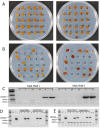Transgene-free genome editing in marine algae by bacterial conjugation - comparison with biolistic CRISPR/Cas9 transformation
- PMID: 30258061
- PMCID: PMC6158232
- DOI: 10.1038/s41598-018-32342-0
Transgene-free genome editing in marine algae by bacterial conjugation - comparison with biolistic CRISPR/Cas9 transformation
Abstract
The CRISPR/Cas9 technology has opened the possibility for targeted genome editing in various organisms including diatom model organisms. One standard method for delivery of vectors to diatom cells is by biolistic particle bombardment. Recently delivery by conjugation was added to the tool-box. An important difference between these methods is that biolistic transformation results in transgene integration of vector DNA into the algae genome, whereas conjugative transformation allows the vector to be maintained as an episome in the recipient cells. In this study, we have used both transformation methods to deliver the CRISPR/Cas9 system to the marine diatom Phaeodactylum tricornutum aiming to induce mutations in a common target gene. This allowed us to compare the two CRISPR/Cas9 delivery systems with regard to mutation efficiency, and to assess potential problems connected to constitutive expression of Cas9. We found that the percentage of CRISPR-induced targeted biallelic mutations are similar for both methods, but an extended growth period might be needed to induce biallelic mutations when the CRISPR/Cas9 system is episomal. Independent of the CRISPR/Cas9 vector system, constitutive expression of Cas9 can cause re-editing of mutant lines with small indels. Complications associated with the biolistic transformation system like the permanent and random integration of foreign DNA into the host genome and unstable mutant lines caused by constitutive expression of Cas9 can be avoided using the episomal CRISPR/Cas9 system. The episomal vector can be eliminated from the diatom cells by removal of selection pressure, resulting in transient Cas9 expression and non-transgenic mutant lines. Depending on legislation, such lines might be considered as non-GMOs.
Conflict of interest statement
The authors declare no competing interests.
Figures





Similar articles
-
Generation of Mutants of Nuclear-Encoded Plastid Proteins Using CRISPR/Cas9 in the Diatom Phaeodactylum tricornutum.Methods Mol Biol. 2018;1829:367-378. doi: 10.1007/978-1-4939-8654-5_24. Methods Mol Biol. 2018. PMID: 29987734
-
Targeted Gene Editing of Nuclear-Encoded Plastid Proteins in Phaeodactylum tricornutum via CRISPR/Cas9.Methods Mol Biol. 2024;2776:269-287. doi: 10.1007/978-1-0716-3726-5_17. Methods Mol Biol. 2024. PMID: 38502511
-
An Expanded Plasmid-Based Genetic Toolbox Enables Cas9 Genome Editing and Stable Maintenance of Synthetic Pathways in Phaeodactylum tricornutum.ACS Synth Biol. 2018 Feb 16;7(2):328-338. doi: 10.1021/acssynbio.7b00191. Epub 2018 Jan 8. ACS Synth Biol. 2018. PMID: 29298053
-
Genome editing in diatoms: achievements and goals.Plant Cell Rep. 2018 Oct;37(10):1401-1408. doi: 10.1007/s00299-018-2334-1. Epub 2018 Aug 23. Plant Cell Rep. 2018. PMID: 30167805 Review.
-
The present and potential future methods for delivering CRISPR/Cas9 components in plants.J Genet Eng Biotechnol. 2020 Jul 7;18(1):25. doi: 10.1186/s43141-020-00036-8. J Genet Eng Biotechnol. 2020. PMID: 32638190 Free PMC article. Review.
Cited by
-
Validating a Promoter Library for Application in Plasmid-Based Diatom Genetic Engineering.ACS Synth Biol. 2023 Nov 17;12(11):3215-3228. doi: 10.1021/acssynbio.3c00163. Epub 2023 Oct 19. ACS Synth Biol. 2023. PMID: 37857380 Free PMC article.
-
Loss of CpFTSY Reduces Photosynthetic Performance and Affects Insertion of PsaC of PSI in Diatoms.Plant Cell Physiol. 2023 Jun 14;64(6):583-603. doi: 10.1093/pcp/pcad014. Plant Cell Physiol. 2023. PMID: 36852859 Free PMC article.
-
Impact of Lhcx2 on Acclimation to Low Iron Conditions in the Diatom Phaeodactylum tricornutum.Front Plant Sci. 2022 Mar 16;13:841058. doi: 10.3389/fpls.2022.841058. eCollection 2022. Front Plant Sci. 2022. PMID: 35371185 Free PMC article.
-
Plasmid-based complementation of large deletions in Phaeodactylum tricornutum biosynthetic genes generated by Cas9 editing.Sci Rep. 2020 Aug 17;10(1):13879. doi: 10.1038/s41598-020-70769-6. Sci Rep. 2020. PMID: 32807825 Free PMC article.
-
Grand Challenges in Microalgae Domestication.Front Plant Sci. 2021 Sep 23;12:764573. doi: 10.3389/fpls.2021.764573. eCollection 2021. Front Plant Sci. 2021. PMID: 34630500 Free PMC article. No abstract available.
References
Publication types
MeSH terms
Grants and funding
LinkOut - more resources
Full Text Sources
Other Literature Sources
Research Materials

